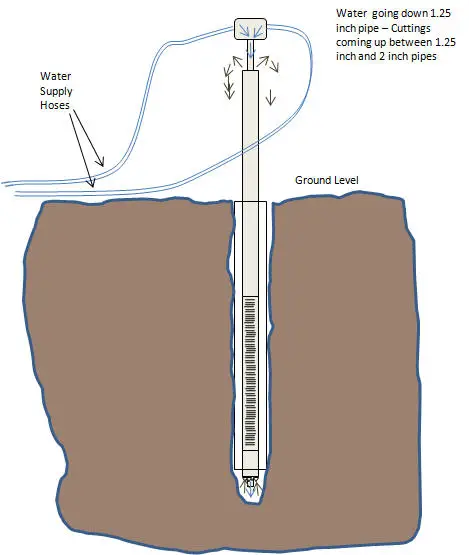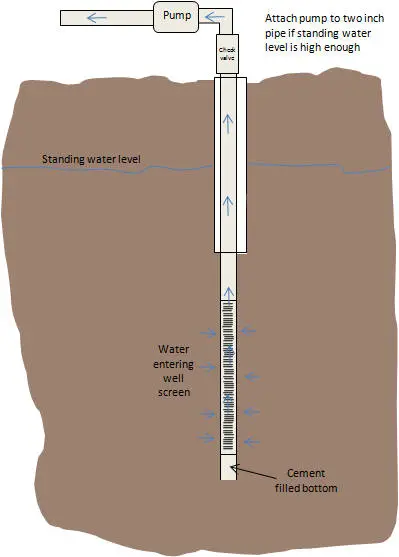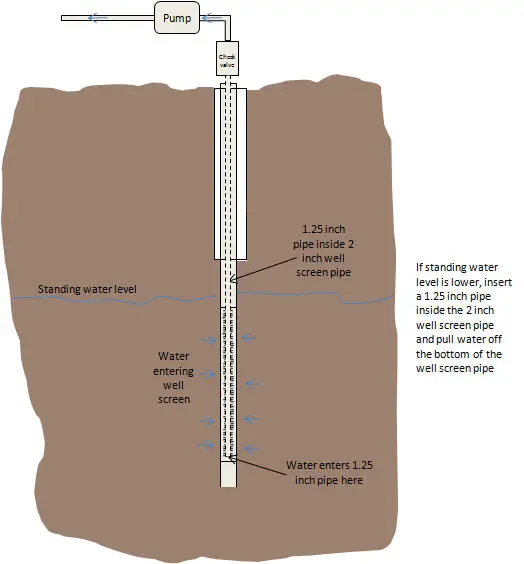First Technique
Before I start on this subject I need to point out that Bill Granade in Tampa is the expert on this subject, not me. Where I live and “drill,” I always encounter mixed layers of sand and clay and I am experienced in dealing with this type of formation. Bill lives and drills on pure sand. His technique is optimized for sand. You should consider his method superior to what I post here. Please check out his pages at Another Home Driller and Beginner’s Tips from Bill.
Drilling in sand presents special problems. I’ve heard from quite a few beach and coastal residents who have experienced problems. On the one hand, drilling in sand is easy. It takes no time at all to wash down 10 or even 20 feet of pipe. On the other hand you are guaranteed to get stuck down around the 20 foot mark if you don’t take some action to avoid it. The sand collapses on the drill pipe almost as quick as you drill/wash your way down through it. After a while, the weight of sand on your drillpipe makes the drillpipe impossible to move.
There are several strategies to overcome this problem. They all work to a degree and will allow you to get a well screen in the ground deeper than you otherwise would have.
Fortunately, in most coastal and beach areas the standing water level is very high – like five to 10 feet. Frequently a 20 foot well will get you all the water you need. Unfortunately, this is sometimes brackish (salty) water so you may need to go a little deeper.
10 FOOT HEAD START
The 10 foot head start method may be helpful when drilling in sand. There is a page on the technique under the menu item, “Drill 10 Feet Deeper” for details. Basically, it just involves washing down a four inch pipe down 10 feet (or as deep as you can get it) and then using that as a well casing to hold the sand off the first 10 feet of your drillpipe.
First Technique for sand: WASHING DOWN A WELL SCREEN
This technique involves using two pipes at onces. You use a small pipe to wash down a larger pipe. Take a 2.00 inch PVC pipe and a 1.25 inch PVC pipe and cut teeth on the bottom end of both.
First let’s talk about the 2.00 inch piece. You want to construct a PVC well screen pipe that can be washed down into the ground and then left there permanently. Cut teeth in the end of a plain piece of 2.00 inch PVC. Then cut it off so that it is one foot long. Next attach it to a 2.00 inch well screen. A longer well screen is better. You can make a long well screen by purchasing multiple sections and gluing them together. Then on top of that, attach some plain 2.00 inch PVC.
Next, make a 1.25 inch drillpipe with a connection for the water supply at the top. Make it about the same length as the well screen piece. So, for example if you got your 10 foot head start (4 inch) piece in the full ten foot, you’d want to start with about a 16 or 17 foot piece of 2 inch well screen and about a 16.5 to 17.5 foot piece of 1.25 inch PVC drillpipe.
The two pieces should look something like this:

Next, attach your water supply to the smaller pipe. Insert the larger pipe down the 10 foot head start 4 inch pipe and the 1.25 inch pipe inside the 2 inch pipe.
Use the 1.25 inch pipe to drill/wash cuttings from just under the bottom end of the two inch well screen pipe so you can push the 2 inch well screen pipe down. Work both the 1.25 inch drill pipe and the 2 inch well screen pipe down into the sand simultaneously..

The idea is to work the well screen pipe as far into the sand as you can. You will need to hammer the larger pipe down when you can no longer push it. Do not bang on the pipe directly, even with a piece of wood. Put a two inch tee on it so the cuttings will go off to the side and hit the tee with a piece of wood – or sledge hammer on the wood. Just work the two inch well screen piece into the ground as far as you can, adding PVC to both the 1.25 inch drillpipe and 2 inch well screen pipe at the same time.
At some point, the two inch well screen piece wiill stick and you will not be able to go any further. Assuming your well screen is under the standing water level when this occurs, that is your well. Pull out the drill pipe. Prime it and test pump the two inch pipe with a pump you don’t mind getting a little sand in.
Assuming it pumps ok and produces water, you need to seal the bottom of the two inch well screen pipe so sand can’t get in. Pour enough cement down the 2 inch pipe to fill up the foot or so of plain PVC at the bottom. Give it a couple days to cure.
If the top of the well screen pipe is at least 10 feet under the standing water level, just attach your pump to the top of the two inch well screen pipe.

If the standing water level is lower, closer to the top of the well screen, then when you start pumping the standing water level will likely fall below the top of the well screen. To avoid sucking air, put a 1.25 inch pipe almost all the way to the bottom of the two inch well screen pipe and attach your pump to the 1.25 inch pipe. That way, you will be pulling water off the very bottom of your well screen pipe. Even if the top of your well screen pipe is not under water you won’t be sucking air.

Finally, after your well is working and you are sure you won’t need to make any changes, seal the top of the well by filling in the four inch “head start” pipe with cement or bentonite. Make sure your well screen is filled in around with sand or pea gravel first because you don’t want your sealant sealing off the screen! If there is any annular space around the four inch pipe, fill this in also. This is to keep groundwater out of your well and it is required by law in most places.
Here is a very interesting note I received from a sand driller that I thought might be useful to others because it is really easy to stick a pipe in sand:
Hi Mike,
Been meaning to write and thank you for all your advice. Your new webpages helped with my ‘sand’ digging. Put down two wells. I used a 3 inch starter pipe and it worked very well. I now have all the water I can use.
One thing I wanted to add about digging in sandy soil– at least around my area. I had my drill pipe- in my first few attempts- get stuck about 15 feet down. Tried everything to get the pipe out. The pipe would turn but would not lift. I left it alone for several hours and went back to give it another try and it pulled right out after just a little effort. Boy was I happy. This happened several times until I added the larger pipe. Might be something to mention to other sandy soil drillers.
Thank again for all your help, Mike. I really couldn’t have done this without your information!
Dannie
 drillyourownwell.com
drillyourownwell.com